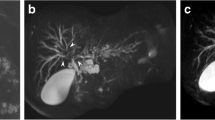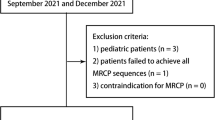Abstract
Purpose
To compare image quality and diagnostic performance of three magnetic resonance cholangiopancreatography (MRCP) protocols in patients with suspected pancreatic abnormalities: free-breathing standard 3D-MRCP (STD), free-breathing compressed sensing 3D-MRCP (CS), and CS 3D-MRCP with acquisition during a single breath-hold > 20 s (BH-CS).
Methods
Informed consent was obtained. We performed 57 MRCPs in 56 prospectively included patients (29 men, median age 59 years). The three protocols were performed in random order. Acquisition time was recorded. Two radiologists blinded to the protocols used 5-point scales to assess image quality parameters (overall image quality, amount of artifacts, background suppression, bile and pancreatic duct visualization) and diagnostic performance (anatomical variants, duct abnormalities, cystic lesions).
Results
Acquisition time was 279 s with STD, 176 s with CS (-37%), and 22 s with BH-CS (-93%). STD and BH-CS were not significantly different for overall image quality, artifacts, or background suppression. The BH-CS group had fewer non-diagnostic scans (3% vs. 19% with STD and 21% with CS, p < 0.05), higher-quality scans (78% vs. 66% with STD and 58% with CS, p < 0.05), and milder artifacts (2% vs. 18% with STD and 16% with CS, p < 0.05). The main pancreatic duct was better visualized with BH-CS compared to STD (p = 0.015) and CS (p < 0.001). Diagnostic performance did not differ across the three protocols. There were fewer indeterminate scans in the BH-CS group.
Conclusion
3T BH-CS is reliable, saves time, and is not associated with decreases in image quality or diagnostic performance compared to STD and CS.



Similar content being viewed by others
References
Barish MA, Yucel EK, Ferrucci JT (1999) Magnetic resonance cholangiopancreatography. N Engl J Med 341:258–264.
Nandalur KR, Hussain HK, Weadock WJ, et al (2008) Possible Biliary Disease: Diagnostic Performance of High-Spatial-Resolution Isotropic 3D T2-weighted MRCP. Radiology 249:883–890.
Irie H, Honda H, Tajima T, et al (1998) Optimal MR cholangiopancreatographic sequence and its clinical application. Radiology 206:379–387.
Wallner BK, Schumacher KA, Weidenmaier W, Friedrich JM (1991) Dilated biliary tract: evaluation with MR cholangiography with a T2-weighted contrast-enhanced fast sequence. Radiology 181:805–808.
Asbach P, Dewey M, Klessen C, et al (2006) Respiratory-triggered MRCP applying parallel acquisition techniques. J Magn Reson Imaging 24:1095–1100.
Zhang J, Israel GM, Hecht EM, Krinsky GA, Babb JS, Lee VS (2006) Isotropic 3D T2-Weighted MR Cholangiopancreatography with Parallel Imaging: Feasibility Study. Am J Roentgenol 187:1564–1570.
Yoshida M, Nakaura T, Inoue T, et al (2018) Magnetic resonance cholangiopancreatography with GRASE sequence at 3.0T: does it improve image quality and acquisition time as compared with 3D TSE? Eur Radiol 28:2436–2443.
Nam JG, Lee JM, Kang H-J, et al (2018) GRASE Revisited: breath-hold three-dimensional (3D) magnetic resonance cholangiopancreatography using a Gradient and Spin Echo (GRASE) technique at 3T. Eur Radiol 28:3721–3728
Lustig M, Donoho D, Pauly JM (2007) Sparse MRI: The application of compressed sensing for rapid MR imaging. Magn Reson Med 58:1182–1195.
Jaspan ON, Fleysher R, Lipton ML (2015) Compressed sensing MRI: a review of the clinical literature. Br J Radiol 88:20150487.
Yang AC, Kretzler M, Sudarski S, Gulani V, Seiberlich N (2016) Sparse Reconstruction Techniques in Magnetic Resonance Imaging: Methods, Applications, and Challenges to Clinical Adoption. Invest Radiol 51:349–364.
Feng L, Benkert T, Block KT, Sodickson DK, Otazo R, Chandarana H (2017) Compressed sensing for body MRI: Compressed Sensing for Body MRI. J Magn Reson Imaging 45:966–987.
Runge VM, Richter JK, Heverhagen JT (2017) Speed in Clinical Magnetic Resonance: Invest Radiol 52:1–17.
Chandarana H, Doshi AM, Shanbhogue A, et al (2016) Three-dimensional MR Cholangiopancreatography in a Breath Hold with Sparsity-based Reconstruction of Highly Undersampled Data. Radiology 280:585–594.
Taron J, Weiss J, Notohamiprodjo M, et al. (2018) Acceleration of Magnetic Resonance Cholangiopancreatography Using Compressed Sensing at 1.5 and 3 T: A Clinical Feasibility Study. Invest Radiol 53:681–688
Zhu L, Wu X, Sun Z, et al (2017) Compressed-Sensing Accelerated 3-Dimensional Magnetic Resonance Cholangiopancreatography: Application in Suspected Pancreatic Diseases. Invest Radiol 53:150–157
Yoon JH, Lee SM, Kang H-J, et al (2017) Clinical Feasibility of 3-Dimensional Magnetic Resonance Cholangiopancreatography Using Compressed Sensing: Comparison of Image Quality and Diagnostic Performance. Invest Radiol 52:612–619.
Zhu L, Xue H, Sun Z, et al (2018) Modified breath-hold compressed-sensing 3D MR cholangiopancreatography with a small field-of-view and high resolution acquisition: Clinical feasibility in biliary and pancreatic disorders. J Magn Reson Imaging 48:1389–1399
Seo N, Park M-S, Han K, et al (2017) Feasibility of 3D navigator-triggered magnetic resonance cholangiopancreatography with combined parallel imaging and compressed sensing reconstruction at 3T. J Magn Reson Imaging 46:1289–1297
Taylor ACF, Little AF, Hennessy OF, Banting SW, Smith PJ, Desmond PV (2002) Prospective assessment of magnetic resonance cholangiopancreatography for noninvasive imaging of the biliary tree. Gastrointest Endosc 55:17–22.
Worters PW, Sung K, Stevens KJ, Koch KM, Hargreaves BA (2013) Compressed-sensing multispectral imaging of the postoperative spine. J Magn Reson Imaging 37:243–248.
Sharma SD, Fong CL, Tzung BS, Law M, Nayak KS (2013) Clinical Image Quality Assessment of Accelerated Magnetic Resonance Neuroimaging Using Compressed Sensing: Invest Radiol 48:638–645.
Author information
Authors and Affiliations
Corresponding author
Ethics declarations
Ethical approval
Approval from the appropriate ethics committee (Comité de Protection de Personnes Ouest IV, #ID RCB: 2017-A02855-48).
Additional information
Publisher's Note
Springer Nature remains neutral with regard to jurisdictional claims in published maps and institutional affiliations.
Rights and permissions
About this article
Cite this article
Mannes, I., Dallongeville, A., Badat, N. et al. Breath-hold compressed-sensing 3D MR cholangiopancreatography compared to free-breathing 3D MR cholangiopancreatography: prospective study of image quality and diagnostic performance in pancreatic disorders. Abdom Radiol 45, 1082–1091 (2020). https://doi.org/10.1007/s00261-019-02254-2
Published:
Issue Date:
DOI: https://doi.org/10.1007/s00261-019-02254-2




